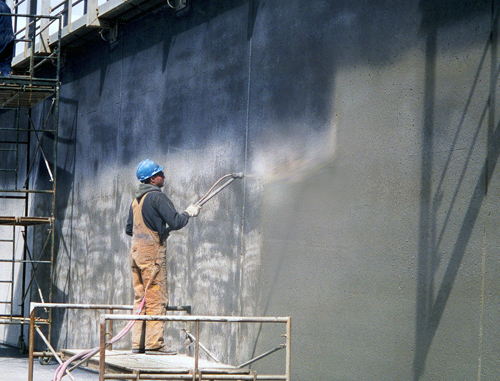Concrete Waterproofing with Crystalline Technology
Type of Construction and Appropriate Crystalline Technology Application
Crystalline waterproofing and protection technology is available in powder form. There are three different application methods:
- Applied as a coating to the surface of an existing concrete structure, for example, a foundation wall or a floor slab.
- Mixed directly into the concrete at the batch plant as an admixture.
- Shaken as a dry powder onto fresh concrete and trowelled into the surface.
Methods and Procedures of Crystalline Waterproofing Coating Applications
Crystalline waterproofing can be applied by brush or with spray equipment. To ensure the success of the application, care must go into the conditions under which the material is applied, i.e. surface preparation, surface wetting, coat thickness, and curing time.
Because the crystalline waterproofing coating system has a unique chemical diffusing characteristic, proper surface preparation of the concrete is critical to the performance of the material. Concrete surfaces that will receive the crystalline waterproofing coating need to have an open pore texture to allow the transfer of the reactive crystalline chemicals from the coating into the concrete substrate. The surface also needs to be clean and free of dirt, form oil, and other foreign matter as this can potentially cause de-lamination of the coating.
The three common methods of concrete surface preparation are water blasting, sand blasting and acid etching. When water blasting, the pressure should be 3,000 pounds per square inch (psi) to 4,000 psi. Sand blasting is normally required when steel forms have been used and the concrete has a tight, mirror like finish. Acid etching can be accomplished using either muriatic acid or citrus-based products when the use of an acid is not environmentally acceptable.
Wetting the Surface
The coating systems require that the concrete be in a saturated, surface damp condition for the waterproofing to be effective. The active chemicals in the coating use water as a migrating or diffusing medium that allows the chemicals to transfer from the coating into the capillary tracts of the concrete. To make sure that concrete on vertical surfaces is saturated, wet the walls with clean water and allow the moisture to be drawn into the substrate for approximately ten minutes. Re-wet the walls a second time and allow to stand for 20 minutes.
In hot weather, when evaporation rates are high, it may be necessary to soak the concrete overnight. This can be accomplished using soaker hoses at the top of walls that allow water to flow down the vertical surfaces, or a series of sprinklers if walls are less than 12 to 15 feet.
If water is not readily available on the job site, the saturation of the concrete should be done early in the morning when evaporation rates are low and before the concrete begins to heat up. In difficult conditions with hot sun and wind it is better to attempt small areas that can be controlled rather than large areas at one time. In hot weather the use of an evaporation retarder to help keep moisture in the concrete can be considered.
In cold weather, saturation of the concrete should only take place when the ambient temperature is going to be above 33 degrees Fahrenheit for 24 hours.
Coating Application
The crystalline waterproofing coating materials are mixed with water at a ratio of five parts powder to two parts water by volume for brush application, and five parts powder to three parts water by volume for spray application. The coverage rate is 1.25 to 1.5 pounds per square yard per coat. At this rate, a 60 pound pail of material will cover 360 to430 square feet, and a 50 pound bag will cover 300 to360 square feet of surface area.
Coatings can be applied by brush, hopper gun or specialized spray equipment. When using a standard six inch masonry brush, one person can mix and apply approximately 80 to100 square feet per hour. A hopper gun or texture gun requires a two-person crew with one mixing the material and the other doing the spraying. The gun uses a 3/8 inch nozzle and operates at roughly 25 psi. A two-person crew can apply the coating at a rate of 400 to500 square feet per hour per coat.
Specialized spray equipment is operated with a three-person crew. At application rates of 1,200 to 1,500 square feet per hour per coat it is necessary to have all materials pre-measured in order to keep up with the spray equipment capacity. When using this type of equipment, the best procedure is to pre-measure the powder into at least five or six large buckets (five gallon pails) and pre-measure the water. This is done on the basis of five parts powder to three parts water by volume.
 |
Sprayed on surface application Photo courtesy of Xypex |
On vertical surfaces, the standard application procedure is to start at the top of the wall and work down. When using spray equipment, the first coat should be “back-brushed” using a 20 inch wide janitors broom with a soft bristle or a finisher’s broom. This helps ensure an even coverage rate and minimizes any run down of the coating.
When a second coat is specified, it needs to be applied no later than 48 hours after the first coat. Under normal conditions, the crystalline waterproofing coating will begin to set up in two to three hours and application of the second coat should be done at this point. If the first coat has dried out, it must be lightly sprayed with water prior to the application of the second coat. Failure to do so may result in lack of bond between the two coats.
When applying the coating materials to a large concrete structure, it is better to break the job up into manageable segments rather than try to complete large areas at one time. This is especially important when the weather is hot or windy.









